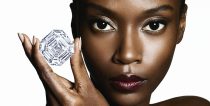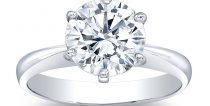Diamond sparkle might be one of the most-desired requirements for an engagement ring. A diamond’s breathtaking light show is one of the reasons we love this gem. But finding a diamond that sparkles requires some knowledge. So let’s get to it!
In this post, we’ll cover:
What Makes a Diamond Sparkle
How to Choose a Diamond that Sparkles
Maximize Diamond Sparkle – What Works/What Doesn’t
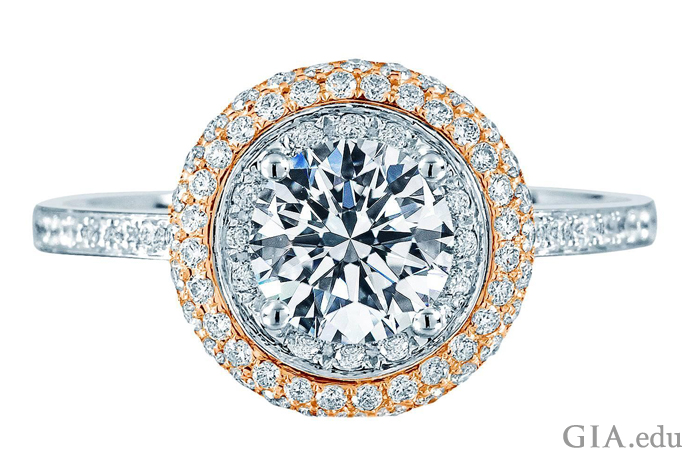
A pavé set diamond halo surrounds a center stone, creating numerous opportunities for sparkle. The diamonds weigh a total of 1.46 carats. Courtesy: 1stdibs.com
What Makes a Diamond Sparkle?
The short answer: light’s interaction with a diamond’s cut. The type and quality of the cut govern how a diamond reacts to the light around it. The angles and relative measurements of a diamond’s facets, as well as its other proportions, have a dramatic effect on how light performs when it strikes a diamond.
The long answer: You probably use the word “sparkle” in a very general way to describe the overall visual effect of a diamond’s interaction with light. But gemologists who have closely studied diamond’s signature light show break it down this way:
When light enters a diamond, it travels through it, reflecting off its interior surfaces, called facets. It then either leaves the diamond as white light, called brightness, or it divides into the spectral colors of the rainbow: red, orange, yellow, green, blue and violet, called fire.
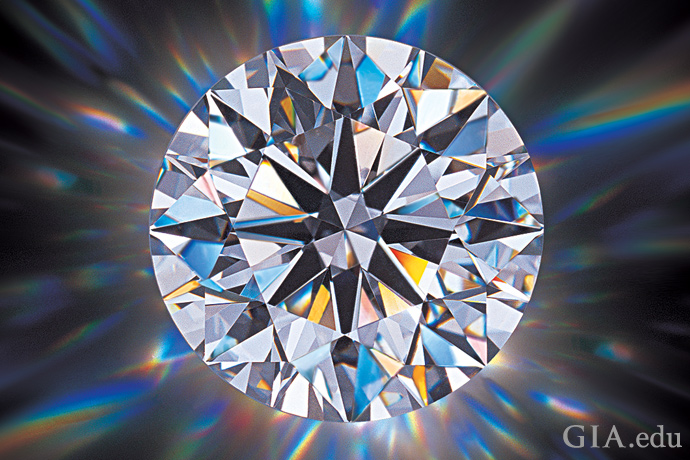
Light leaving a diamond as spectral colors can be quite breathtaking. Copyright: GIA and Harold & Erica Van Pelt.
As you or the diamond moves, an effect called scintillation occurs – visible as alternating flashes of white and spectral-colored light and the contrast of dark and light that moves around the diamond. This contrast is dynamic and causes, in layperson’s terms, sparkle.
How to Choose a Diamond that Sparkles
Since diamond sparkle is all about how well the stone interacts with light, the environment in which you view the diamond and the diamond’s cut quality are critical.
1. Be sure to examine the diamond under four different light sources. Spot lighting (or a lot of individual light sources) is the best way to see all the elements that produce sparkle. However, if there are too many spot lights and they are too bright, there will be so much glare that one diamond will look just as good as any other.
To avoid this, observe the diamond in an environment where the spot lighting is not overwhelming. Then look at the diamond in diffused lighting — fluorescent lights that bounce light off a white ceiling are best. Third, try to view it in a mixed lighting environment of spotlights and diffused lighting. And, finally, don’t forget to view the diamond in natural daylight.
Learn more about how light affects the appearance of a diamond.
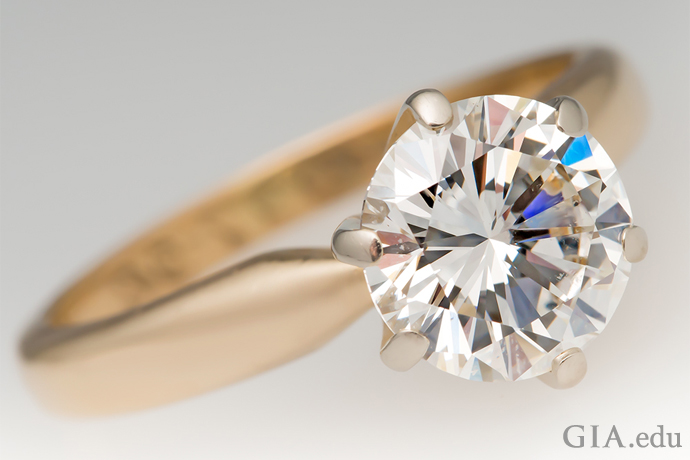
A 1.52 carat (ct) round brilliant diamond is a visual delight in this engagement ring. Courtesy: EraGem
2. Pay attention to cutting style. The more facets a diamond has, the more reflective surfaces there are to bounce and scatter light. A round brilliant cut diamond with its 57 or 58 facets will appear to have more sparkle than a single-cut diamond with only 17 or 18 facets. Learn how to pick a round brilliant diamond engagement ring.
If you have your heart set on a shape other than round, you can still get the sparkle if you look for diamond shapes cut in the brilliant faceting style. These include princess, radiant, oval, pear, heart and marquise.
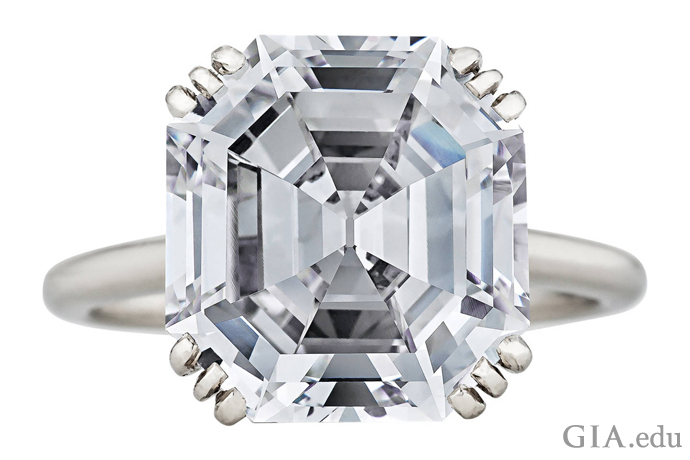
This 8.06 ct Asscher cut diamond from Cartier, circa 1935, is spectacular. Courtesy: 1stdibs.com
3. Pay attention to cut quality. There’s another solution for standard round brilliants, if you’re unsure about judging a diamond’s sparkle. A GIA Diamond Grading Report can be of great value in finding a diamond that sparkles. GIA issues one of five cut grades for a round brilliant diamond: Excellent, Very Good, Good, Fair and Poor.
A diamond with an Excellent cut grade is very bright. It shows an even pattern with good contrast between light and dark areas, so the reflections appear crisp and well balanced. This tells you that the cutter created the best possible stone from the rough.
A Very Good cut grade means the diamond has bright areas evenly distributed across the stone’s crown and few distracting areas.
A diamond with a Good cut grade isn’t quite as bright – reflections aren’t as sharp and there’s more darkness or dullness in the diamond.
A diamond with a Poor cut grade has much more prominent dark areas or dullness. Given the choice, most people would pick diamonds with either Very Good or Excellent grades.
 This diamond has an Excellent cut grade: It is very bright and shows an even pattern with good contrast between light and dark areas. Reflections appear crisp and well balanced. If all else is equal, an Excellent cut grade pretty much guarantees an extremely attractive diamond. Photo: Al Gilbertson and Barak Green/GIA. |
 This diamond has a Good cut grade. Its bright-reflections aren’t as sharp and there’s more darkening around the girdle. Photo: Al Gilbertson and Barak Green/GIA. |
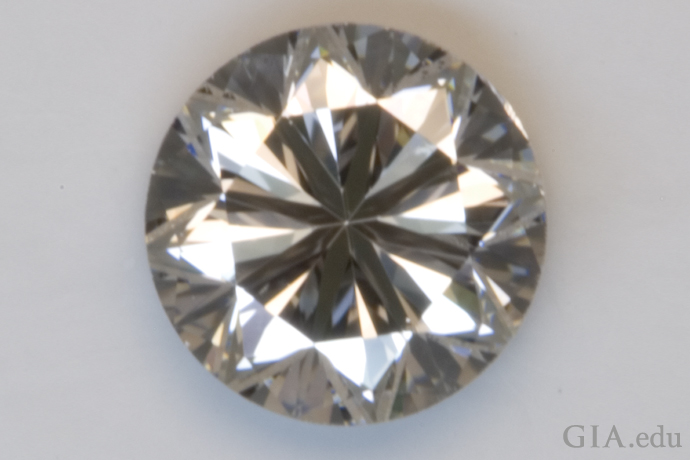 This diamond has a Poor cut grade. It has significantly more prominent dark areas; there’s a much smaller bright area. Photo: Al Gilbertson and Barak Green/GIA. |
Learn more about how GIA grades diamond cut.
Maximizing Diamond Sparkle – What Works/What Doesn’t
Looking for more visual bang for your buck when purchasing a diamond engagement ring? Here are some tips for getting the most diamond sparkle.
1. Bigger is not necessarily better. You may think: the larger the diamond, the more sparkle. But in reality, diamonds with identical proportions, color and clarity have the same amount of sparkle regardless of size. Visually, you might perceive a difference when comparing two diamonds that are dramatically different in size. For example, a 0.25 ct diamond may appear to sparkle less than the 1.00 ct diamond next to it. But when it comes to choosing a diamond, typically you’re making a selection between diamonds that fall within a narrow size range, so slight differences in diamond size would have no effect on your perception of sparkle. Again, this assumes the cut quality of the diamonds being compared is the same.
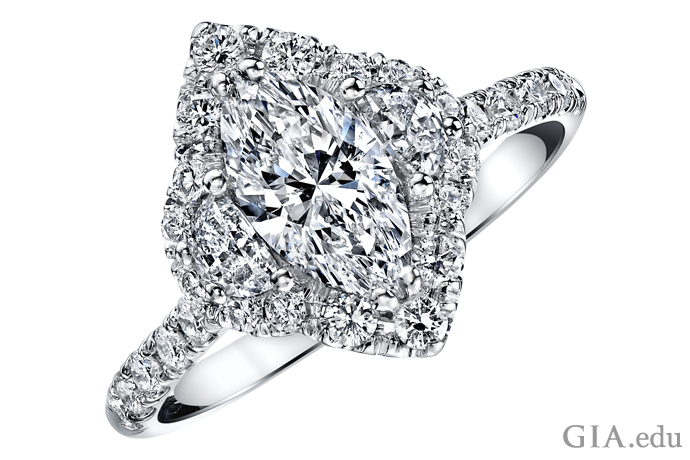
Talk about sparkle! This three-stone engagement ring seems to have it all. A marquise-shaped diamond in the center is flanked by two half–round brilliant cut diamonds, all of which are surrounded by more diamonds in a pavé setting that extends along the ring’s shank. Courtesy: ZIVA Jewels Inc.
2. Choose a diamond with good color and clarity. Researchers have found that brightness diminishes in diamonds that grade lower on the D-to-Z color range. Likewise, clarity issues in diamonds graded SI2 or I can diminish the appearance of fire. Both will reduce the sparkle in a diamond.
3. More diamonds, more sparkle. Definitely yes! More diamonds, whether big or small, will add more sparkle to your engagement ring. This is one reason why diamond side stones and pavé settings are so popular.
4. Pick the right setting. If you’re looking for a bigger visual display, a prong setting is better at allowing light to enter the diamond than bezel settings that cover more of the top surface of the diamond. Learn more about different setting styles.
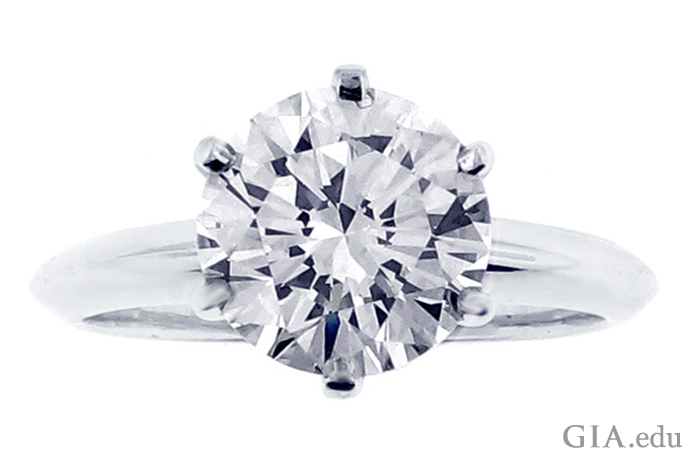
You can have lots of sparkle and still have a simple ring design. This solitaire engagement ring by Tiffany & Co. features a 2.28 ct round brilliant diamond. Courtesy: Pampillonia Estate and Fine Jewelry
5. Keep the diamond clean. This is probably the most important (and affordable) tip. A diamond that’s dirty will not sparkle. Diamonds have an affinity for grease, so it’s important to clean them regularly. Find out how to keep your diamond clean.
In the end, nothing adds sparkle to an engagement ring like the love with which it’s given. So follow your heart and relish the moment — you really can’t go wrong.
If you need a little extra help as you shop, check out our glossary of common engagement ring terms. They’ll help you better communicate your needs and desires with a jeweler.


